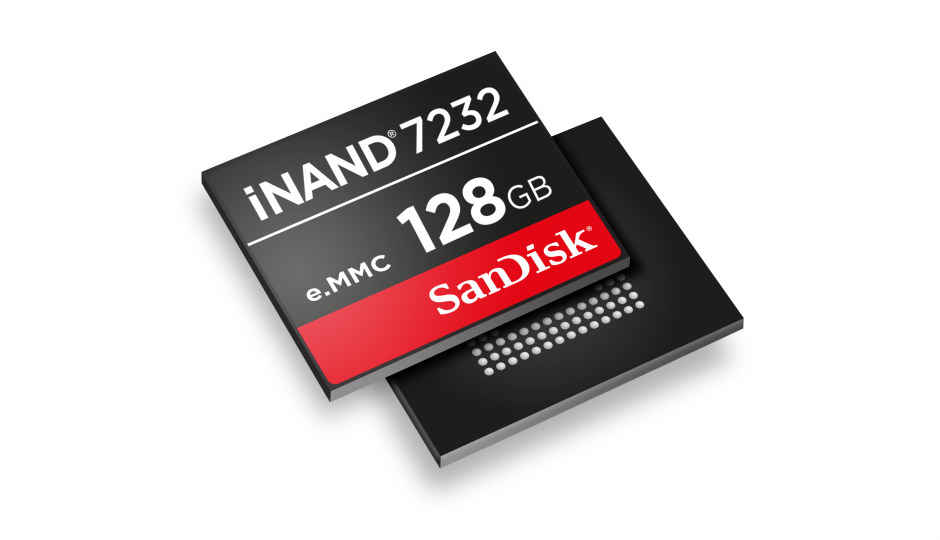SanDisk unveils iNAND 7232, a faster storage for mobile devices
SanDisk unveiled iNAND 7232 today at MWC Shanghai which is a faster storage for mobile devices and uses SLC caching

Today at MWC, Shanghai, SanDisk announced its latest iNAND 7232 storage solution for mobile devices. The iNAND 7232 is a successor to the iNAND 7132. This is a significant launch in mobile storage space as SanDisk applies its SLC caching, mainly used in its consumer grade SSDs. These mobile storage solutions also provide high sequential read speeds of 280 MB/s, and sequential write speeds of 150 MB/s. The new iNAND 7232 will be available in 32, 64 and 128GB SKUs. Currently they are under sampling with partner OEMs, and will feature in upcoming smart devices by fall 2015.
 Survey
SurveyHere is the full press release from SanDisk detailing its 10th anniversary and the launch of iNAND 7232 storage solution.
SanDisk Ships its Two Billionth microSD card as Technology Marks 10-year Anniversary
Invented by SanDisk in 2004, the microSD format was initially known as TransFlash™. In 2005 SanDisk contributed the technology to the SD Card Association who renamed and released the final specifications for the microSD format on July 13, 2005. This format has become the most popular removable memory card in SanDisk’s history. Collectively, SanDisk’s two billion microSD cards could store an estimated 11,103 billion megabytes (MB)* worth of memory – the equivalent of more than 100MB of flash storage for every man, woman and child that ever lived on Earth.
The microSD card —which reduced the size of removable memory cards by approximately 75 percent —has played a pivotal role in a wide variety of consumer markets. For example, the vast majority of “point of view” or action cameras — the fastest-growing segment in digital imaging — are based around the microSD format.
The microSD format has also helped propel the smartphone market by giving both manufacturers and consumers greater flexibility and freedom. Approximately 75 percent of smartphone models on the market today contain microSD slots, according to data from Strategy Analytics1. Google included microSD slots in two of its fastest growing and largest mobile product segments — Android One, its mobile operating system for sub-$200 phones, and phones designed for emerging markets. Android M, Google’s next mobile operating system, and Windows Mobile both permit consumers to run applications directly on microSD cards and/or increase the primary storage capacity of their devices.
"Demand for storage never stops growing. We will soon see smartphones with multiple-aperture lenses, phones capable of shooting UltraHD video and applications for taking and viewing virtual reality environments,” said Rajesh Gupta, Country Manager – India & SAARC SanDisk. “microSD memory cards will also be instrumental in the growth of the Internet of Things by lowering the barrier to experimentation. Two billion is just the beginning, and we look forward to contributing to future technologies enabled by the microSD format.”
A decade of SanDisk microSD technology:
- The first microSD cards featured capacities starting at 32MB. SanDisk’s latest microSD form factor card is a microSDXC that offers up to 200GB of capacity, a 6,250x increase in just 10 years.
- It took three years for CompactFlash cards to reach one million shipments. By contrast, over one million microSD cards were shipped in the first full quarter of availability.
- On average, SanDisk has shipped 6.34 microSD cards every second since the formal unveiling of the specifications.
- If you lined up SanDisk’s two billion microSD cards end-to-end, they would extend 18,451 miles or three-quarters of the way around the world.
- In 2014, SanDisk announced 128GB SanDisk Ultra microSDXC™ UHS-I memory card, a twist on the format that enabled the company to vertically stack up to 16 memory die in the same card and expand capacity without changing the footprint of the device. Each memory die in this microSDXC card is thinner than a strand of hair.
- In 2015, SanDisk introduced the 200GB SanDisk Ultra® microSDXC™ UHS-I card, Premium Edition, a high capacity for the form factor, upping capacity by 56 percent in just one year.
- SanDisk flash memory cards have held the number-one market share position worldwide for 13 straight years.
With more than 5,000 patents, SanDisk positively impacts many markets through its flash memory innovations. In recognition of its achievements, SanDisk was named a Thompson Reuters 2014 Top 100 Global Innovator, an honor the company has received for four consecutive years.
SanDisk at Mobile World Congress Shanghai
SanDisk also introduced separately today the iNAND® 7232 storage solution, a new, advanced embedded storage solution optimized to deliver best-in-class imaging performance and superior storage capacity in flagship mobile devices. SanDisk will be displaying its complete line of embedded and removable mobile memory solutions, including the new iNAND 7232 storage solution, in the company’s Mobile World Congress Shanghai 2015 booth (Hall 5, Booth #W5 G.90).